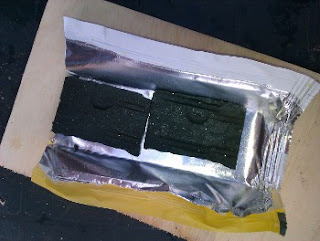I wasn't able to get a picture of one using my camera phone and microscope so here's a link to a google image search for Varroa Destructor. As you can see they're rather large as mites go in comparison to their hosts, and look a little like crabs. For a comparison it's a bit like if you were being parasitised by medium sized cats.
There's a few ways to treat a honeybee colony for varroa and most people use a mix of measures. The most ubiquitous one is replacing bee hive floors with a wire mesh so any falling mites leave the hive. You can brush icing sugar into the hive which is supposed to loosen the mites' grip on the bees causing them to drop off. You then put a monitoring tray below the hive and count the number of mites that fall. I tried this and saw exactly no mites at all. Either it didn't work or ants, wasps or whatever gobbled up the mites before I saw them. It did make the bees look amusing as they buzzed round the garden covered in icing sugar like little angry ghosts. another way to check a colony for mites is to use a capping fork to pull out a load of drone larvae, the mites prefer the drone larvae, then you can count the mites on the larvae. I did this too and saw no mites either.
After the open mesh floor the next step is some kind of chemically type thing to kill the mites and not the bees. In different countries there's different substances you're legally allowed to use. I opt to use something called Apilife Var -it's a mix of thymol, Eucalyptus Oil, Menthol and Camphor. It certainly smells strongly and probably clears a blocked nose faster than Vicks. The theory is is suffocates the mites but doesn't harm the bees.
 |
| Apilife Var |
 |
| Apilife Var in brood box |
It seems to work rather well and I was soon seeing dead mites dropping onto the monitoring board beneath my strongly medicinal smelling hives. Whilst it may not harm the bees it seriously annoys them. To get the above picture of the broken biscuit in the hive corners I had to smoke the bees and photograph it quickly because it doesn't take long before the bees start attacking the stuff. They shred it and throw it out. Because of this you have to repeat it four times on a weekly basis.
You can't get rid of the varroa from a colony completely so what beekeepers try to do is keep the varroa population at a level that doesn't impact the bees too heavily. There was an article on a BBC program this year about a chap who seems to be making headway in developing bees that will groom each other and pull off the mites -as the asian bees do, but it's probably going to be a long time before we have self grooming bees.









No comments:
Post a Comment